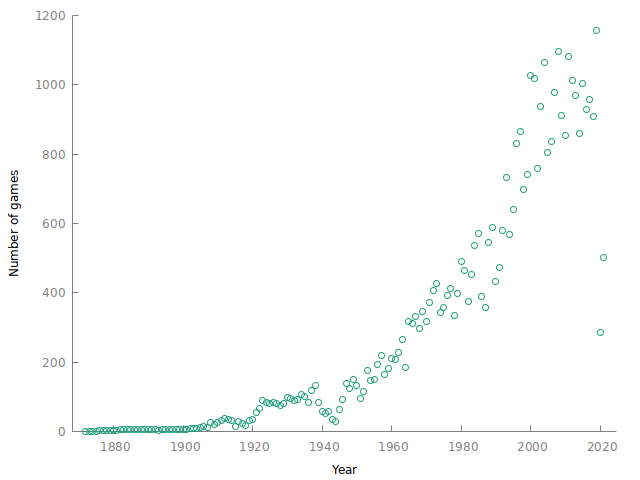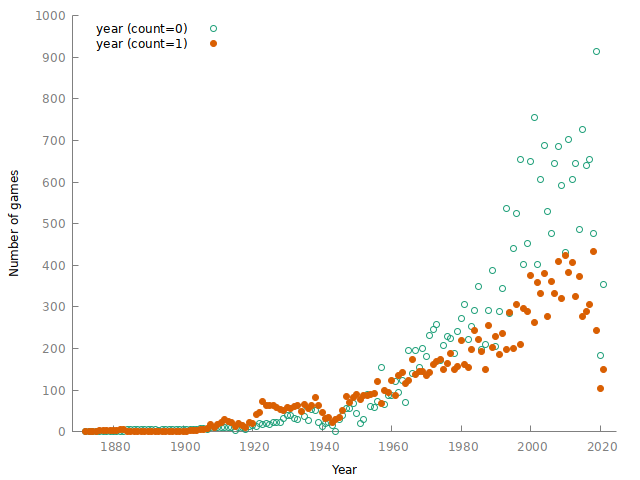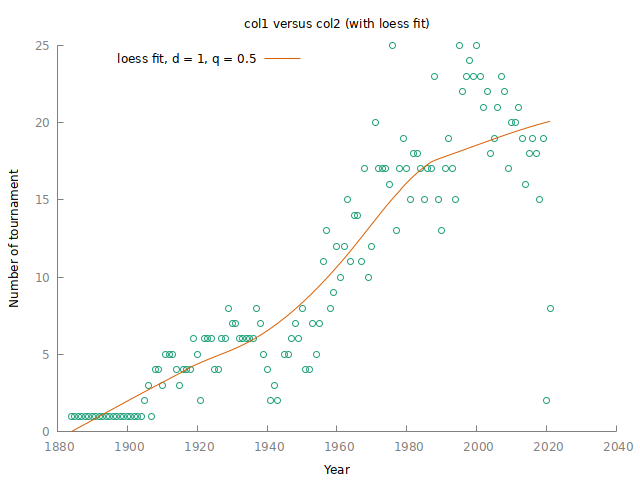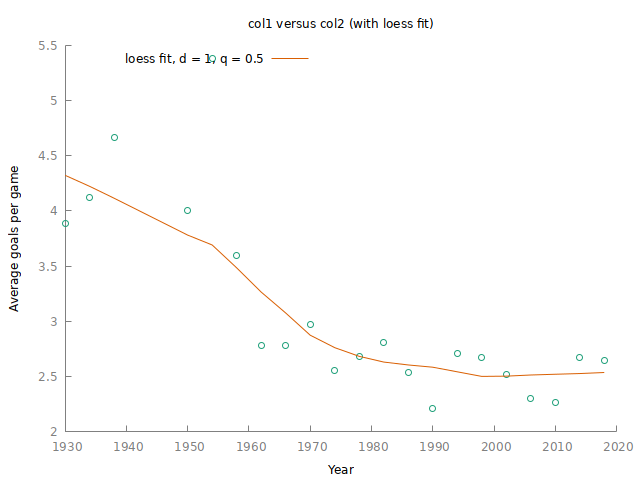Introduction
Recently I stumbled over Julius Krumbiegel’s nice little data analysis exercise entitled “Analyzing international football results with Julia”. As the title already says, he’s using Julia for this task.
The dataset used is cool, and I thought that this may be a nice little exercise to show how to replicate Julius' results using my favourite data tool named gretl – an open-source statistics and econometrics cross-platform software.
You can find my repository hosting the script, data and output of this exercise here.
Let’s start
I assume that you’ve a working gretl version installed on your machine. (If you want to compile gretl on your own on an Ubuntu machine – which don’t necessarily need to do – see here for my manual).
Initial settings
Let’s start with some parameter definitions and setting up the working directory.
Note: Replace the DIR_WORK parameter by your respective path.
clear
set verbose off
#set datacols 6 # This only works since gretl 2021c
# Parameters
string DIR_WORK = "/home/at/git/football_data"
string URL = "https://raw.githubusercontent.com/martj42/international_results/master/results.csv"
# Alternatively load it from my github-repo:
# string URL = "https://github.com/atecon/football_results/blob/master/data/data_raw.csv"
scalar LOAD_DATA_FROM_WEB = TRUE # only initially needed
# Set the working directory
set workdir "@DIR_WORK"
Let’s also install and load two 3rd party libraries (for details on the pkg command, execute help pkg):
# Install necessary package(s) automatically if not available on your local machine
pkg query calendar_utils --quiet
if !nelem($result)
pkg install calendar_utils
endif
pkg query multiplot --quiet
if !nelem($result)
pkg install multiplot
endif
include calendar_utils.gfn
include multiplot.gfn
On a linux machine you can execute the following command to create two new folders namely ./output and ./data within your working directory. In case you use another OS, please create those directories on your own before.
if $sysinfo.os == "linux"
shell mkdir -p data output
endif
Download the dataset
The data is available as a csv file on github as stated at the beginning. I’ve already defined the parameter URL directing to it.
For loading a csv file and opening it with gretl, we can simply use the open command:
if LOAD_DATA_FROM_WEB == TRUE
# Load the data from the web
open "@URL" --quiet --preserve --all-cols
# Store the data locally (just to have it...)
store "./data/data_raw.csv"
else
open "./data/data_raw.csv" --preserve --all-cols
endif
Let’s print the first 10 rows of the dataset:
print --byobs --range=1:10
home_team away_team home_score away_score tournament
1872-11-30 Scotland England 0 0 Friendly
1873-03-08 England Scotland 4 2 Friendly
1874-03-07 Scotland England 2 1 Friendly
1875-03-06 England Scotland 2 2 Friendly
1876-03-04 Scotland England 3 0 Friendly
1876-03-25 Scotland Wales 4 0 Friendly
1877-03-03 England Scotland 1 3 Friendly
1877-03-05 Wales Scotland 0 2 Friendly
1878-03-02 Scotland England 7 2 Friendly
1878-03-23 Scotland Wales 9 0 Friendly
city country neutral
1872-11-30 Glasgow Scotland FALSE
1873-03-08 London England FALSE
1874-03-07 Glasgow Scotland FALSE
1875-03-06 London England FALSE
1876-03-04 Glasgow Scotland FALSE
1876-03-25 Glasgow Scotland FALSE
1877-03-03 London England FALSE
1877-03-05 Wrexham Wales FALSE
1878-03-02 Glasgow Scotland FALSE
1878-03-23 Glasgow Scotland FALSE
You can see the columns (variables) – called series in gretl jargon – the dataset comprises. There is a mix of numerical as well as string-valued series.
Create some calendar series
For the following tasks its useful to decompose the date string into a series holding the year, month and day, respectively.
To do so, we first apply the dates_to_iso8601() function from the “calendar utils” package for casting the date string series into the numerical ISO8601 format.
The built-in icoconv() function does the actual decomposition using the integer-valued series date:
series date_iso = dates_to_iso8601(date, "%Y-%m-%d")
series year, month, day
isoconv(date_iso, &year, &month, &day)
print date date_iso year month day -o --range=1:5
The printout is as follows:
date_string date year month day
1 1872-11-30 18721130 1872 11 30
2 1873-03-08 18730308 1873 3 8
3 1874-03-07 18740307 1874 3 7
4 1875-03-06 18750306 1875 3 6
5 1876-03-04 18760304 1876 3 4
Let’s start with the actual analysis
Number of games per year
Some initial question might be: How many games were played per year? To answer this question, we need to transform the data by grouping it by the series year. A group-by can be done via the aggregate() function (execute help aggregate or see here for details) which returns a matrix:
## Count the number of entries (and hence games) per year
matrix gpy = aggregate(year, year)
gpy = mreverse(gpy, TRUE) # swap the columns
print gpy --range=1:10
gpy (150 x 2)
count byvar
1 1872
1 1873
1 1874
1 1875
2 1876
2 1877
2 1878
3 1879
3 1880
3 1881
The count column simply refers to the number of entries of year for each year, and hence the number of games played.
For plotting, we use gretl’s plot command. Gretl can plot both series as well as matrices. For details on the plot command, see here.
Here we plot the columns of matrix gpy and store the plot in the ./output folder created initially:
plot gpy
options fit=none
literal set xlabel "Year"
literal set ylabel "Number of games"
end plot --output="./output/games_per_year.png"

The number of games per year has surged since the 1950s.
Number of games per year grouped by tournament
In order to plot the number of games for friendly games and others, respectively, it’s useful to compile a so called factorized plot.
For this, we create a binary variable named friendly which takes the value 1 for friendly games, and otherwise 0. This factor series can be used as an additional grouping series for the aggregate function.
series friendly = (tournament == "Friendly")
print tournament friendly -o --range=1:5
list by = year friendly
matrix gpyf = aggregate(year, by)
print gpyf --range=1:5
The output is
tournament friendly
1 Friendly 1
2 Friendly 1
3 Friendly 1
4 Friendly 1
5 Friendly 1
gpyf (300 x 3)
year friendly count
1872 0 0
1872 1 1
1873 0 0
1873 1 1
1874 0 0
The plotting is done as before
# For plotting, re-arrange the column order:
gpyf = gpyf[,{3, 1, 2}] # 3rd column first, 1st col. second etc.
plot gpyf
options fit=none dummy
literal set xlabel "Year"
literal set ylabel "Number of games"
end plot --output="./output/games_per_year_factorized.png"
The number of both friendlies and competitions have increased over time, although competitions have risen faster which is may be not too surprising given that these games are commercially more attractive (but this just a hypothesis).

Number of competitions per year
Next, we want to plot the number of unique tournaments per year. Again we make use of the aggregate function. Again we need to group by year. However, as the aggregation method we want to count the unique occurrences of a type of competition.
As this aggregation method is not supported by gretl, we need to write our own function which I simply call unique_entries().
function scalar unique_entries (const series y)
/* Aggregation function: Compute the number of unique entries of 'y'
return: int, number of unique entries. */
return rows(values(y))
end function
This function consumes a series as input, and returns the number of unique values of that series. We can refer to our function unique_entries() when calling aggregate().
# Don't consider friendlies
smpl tournament != "Friendly" --restrict --replace
matrix tpy = aggregate(tournament, year, unique_entries)
tpy = mreverse(tpy, TRUE)
tpy = tpy[,{1, 3}]
tpy (137 x 2)
1 1884
1 1885
1 1886
1 1887
1 1888
1 1889
1 1890
1 1891
1 1892
1 1893
The scatter plot with a joint Loess-fit is compiled by:
plot tpy
options fit=loess dummy
literal set xlabel "Year"
literal set ylabel "Number of tournament"
end plot --output="./output/number_of_tournament_per_year.png"

As can be seen, the number of competitions has risen over the years with a peak around the year 2000.
Average number of teams per competition
Plotting the average number of teams per competition grouped by year and tournament is actually not that simple to realize in gretl. We skip this here.
Number of goals per game
Another interesting question, is how the number of goals per game during the world cups has developed over time.
smpl full
series goals = home_score + away_score
smpl tournament == "FIFA World Cup" --restrict
matrix gpg = aggregate(goals, year, mean)
gpg = gpg[,{3, 1}]
plot gpg
options fit=loess dummy
literal set xlabel "Year"
literal set ylabel "Average goals per game"
end plot --output="./output/avg_goals_per_game.png"

The number of goals has been around 4 until the 1950s before stabilizing around 2.5 since the 1970s.
Frequency plot of goals per game
For this exercise, let’s produce two frequency plots: One for the year 1954 and another for 1990.
For compiling a multiplot we make use of the “multiplot” package.
smpl full
series goaldiff = abs(home_score - away_score)
matrix years = {1954; 1990}
strings filenames = array(nelem(years)) # store temporary plot files
loop i=1..rows(years)
smpl year == years[i] && tournament == "FIFA World Cup" --restrict --replace
filenames[i] = sprintf("%s/plot$i.gp", $dotdir)
string fname = filenames[i]
freq goaldiff --plot="@fname"
endloop
# Compile final plot
multiplot(filenames, "./output/frequency_goal_difference.png")

Thus, in 1954 the spread of goals was substantial ranging from zero to even 9(!), indicating that the class between teams really differed. In 1990, most games were decided by one goal difference, in comparison.
Probability of winning as the home team
Let’s compute some helper series first. You also will see how to construct a string-valued series in gretl using the stringify() function.
smpl full
series win = (home_score > away_score) ? 1 : 0
series lose = (home_score < away_score) ? 2 : 0
series tie = (win == 0 && lose == 0) ? 3 : 0
# Create a string-valued series
strings score_labels = defarray("win", "lose", "tie")
series home_result = win + lose + tie
stringify(home_result, score_labels)
smpl home_result home_score away_score --no-missing
print home_result home_score away_score -o --range=1:5
home_result home_score away_score
1 tie 0 0
2 win 4 2
3 win 2 1
4 tie 2 2
5 win 3 0
Now compute the relative frequencies
matrix m = aggregate(home_result, home_result)
m[,2] = m[,2]./ $nobs # compute relative frequencies
rnameset(m, score_labels)
print m
m (3 x 2)
byvar count
win 1.0000 0.48631
lose 2.0000 0.28321
tie 3.0000 0.23048
So, indeed the chance of winning as the home team is almost 50%. This could be a bit misleading, potentially, if the better teams are also somehow the teams that host more games.
Julius' last exercise I am not replicating here but I leave it as an exercise for you.